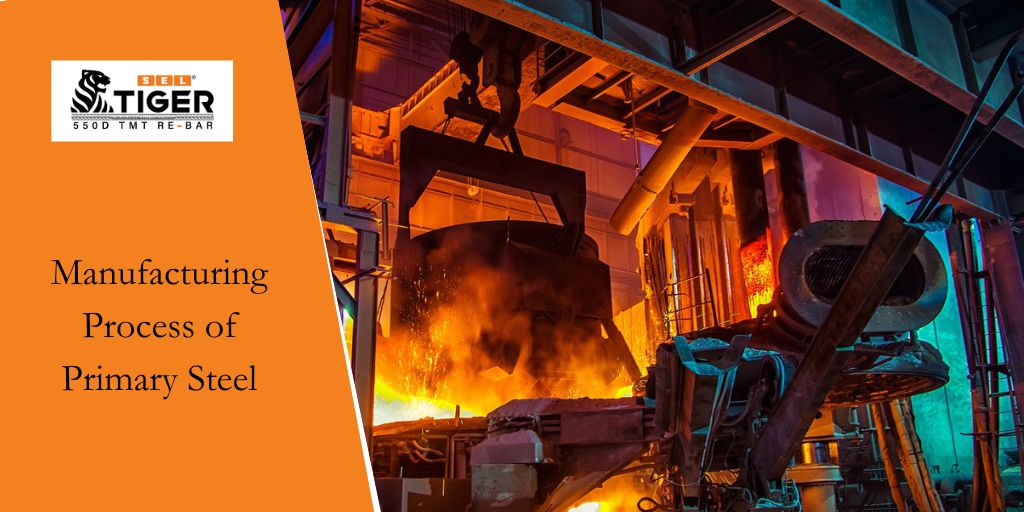
Steel is one of the most widely used materials in the world. Owing to its physical and mechanical properties, steel has become a part of our everyday life, and one of the most common applications of steel we see today is as a TMT bar in the construction industry. According to data, building and infrastructure accounts for 50% of steel demand. The manufacturing of TMT bar is done either through primary steel, or secondary steel. Both of which defines the TMT bar grade, and it’s application in the construction industry. The top TMT bar brands in India uses primary steel for manufacturing of Fe 500, and Fe550 D grade TMT bars.
So, what is primary steel, and how is it manufactured? New to this term? Well, as a leading primary steel manufacturer, we are here to answer your query. Let’s delve into the blog to know what is primary steel, and how is it manufactured.
Primary steel, also known as raw steel, is the initial form of steel that is created from iron ore. It is the foundational stage in the steel production process before any further refinement or modification.
The principle of steel making includes melting, purifying, and alloying processes carried out at an approximate temperature of 1600 degrees Celsius in molten conditions. In the process, various chemical reactions are initiated, either in sequence or simultaneously to achieve the desired result at specified chemical composition and temperature.
In a summarised format, the process of making primary steel involves the melting of carbon-rich pig iron in a Basic Oxygen Furnace (BOS) in which pure oxygen is passed through to remove impurities from pig iron, the molten pig iron is then cooled down in casting process to manufacture primary steel. Let’s break down the whole process.
Before manufacturing any product, it is important to prepare the raw material. The primary steel manufacturers initiate the manufacturing by processing iron ore. The ore extracted through mining contains dirt and debris, which cannot be used as it is. For this, centring of the ore is done, it is the process where iron ore is separated into smaller sections and then crushed in with sand. From the crushed ore, metal and non-metal are removed with the help of magnetic separation.
Sintering is important for the overall process. In this, the iron ore concentrates are mixed with other additives such as limestone, coke breeze, benzonite and heated, this process is called “sinter”. This creates sintered agglomerates that have physical and chemical properties for subsequent processing.
The mixture is added to the blast furnace (typically made of refractory brick). In the blast furnace, hot air is passed which chemically reacts with coke, limestone and benzonite. This process is done to reduce iron in the ore, hence producing molten metal. This process involves the breakdown of carbon and oxygen to form carbon monoxide which is the flux and which is removed as slag with Fe.
Read Also: How to find the best TMT rebar manufacturer in Jaipur?
From the blast furnace, the molten metal is converted into a solid state, where it is called pig iron. Pig iron is raw iron which is also known as crude iron, and this is used in the manufacturing of steel. However, in pig iron, the percentage of carbon is excessive around 3.7 -4.8% of carbon weight, which needs to be reduced to make it suitable for the construction industry.
The pig iron is used for manufacturing of steel. This process is known as the refining of molten iron to reduce carbon and remove impurities. The refining process is carried out in a basic oxygen furnace, or an electric arc furnace.
The state-of-the-art manufacturing unit at the steel manufacturer’s extensive production unit contains a ladle, it is a refractory lined container where molten pig iron is added. The metal in the ladle is sent directly to the basic oxygen steelmaking process. This is done to reduce sulphur, phosphorus, and silicon from the molten iron. For desulphuring pretreatment, a lance is lowered into the molten iron which is present in the ladle, and hundreds of kilogram of Magnesium is added, which is reduced to magnesium sulphide in a violent exothermic reaction. This is helpful in racking off suphide, once it is racked off BOS process is continued. This process determines the quality of steel.
After steelmaking, the molten steel is transformed into solidified steel through a continuous endothermic reaction as it is poured into the water-cooled copper mould. This process is known as Casting. It is useful in the production of billets, blooms, or slabs.
In the finishing process, the solid steel goes through an additional process, which includes hot rolling, cold rolling heat treatment, and surface treatment that helps to obtain the desired properties and shapes for different applications. This involves the processing of billets, slabs, and blooms into steel sheets, coils, bars, rods, and other products.
SEL Tiger TMT is one of the top TMT brands in India. Our in-house research and development, along with the extensive production unit ensures quality in primary steel, which are eventually utilised for TMT bar production. As a primary steel manufacturer, we use iron ore and coal to produce 100% pure steel by integrating a German-based quenching system–THERMEX. Our products are certified for CRS Grades and MS through IS 2830:2012 compliance. The primary steel is used to manufacture TMT bar og grade FE415, and FE 550 D.